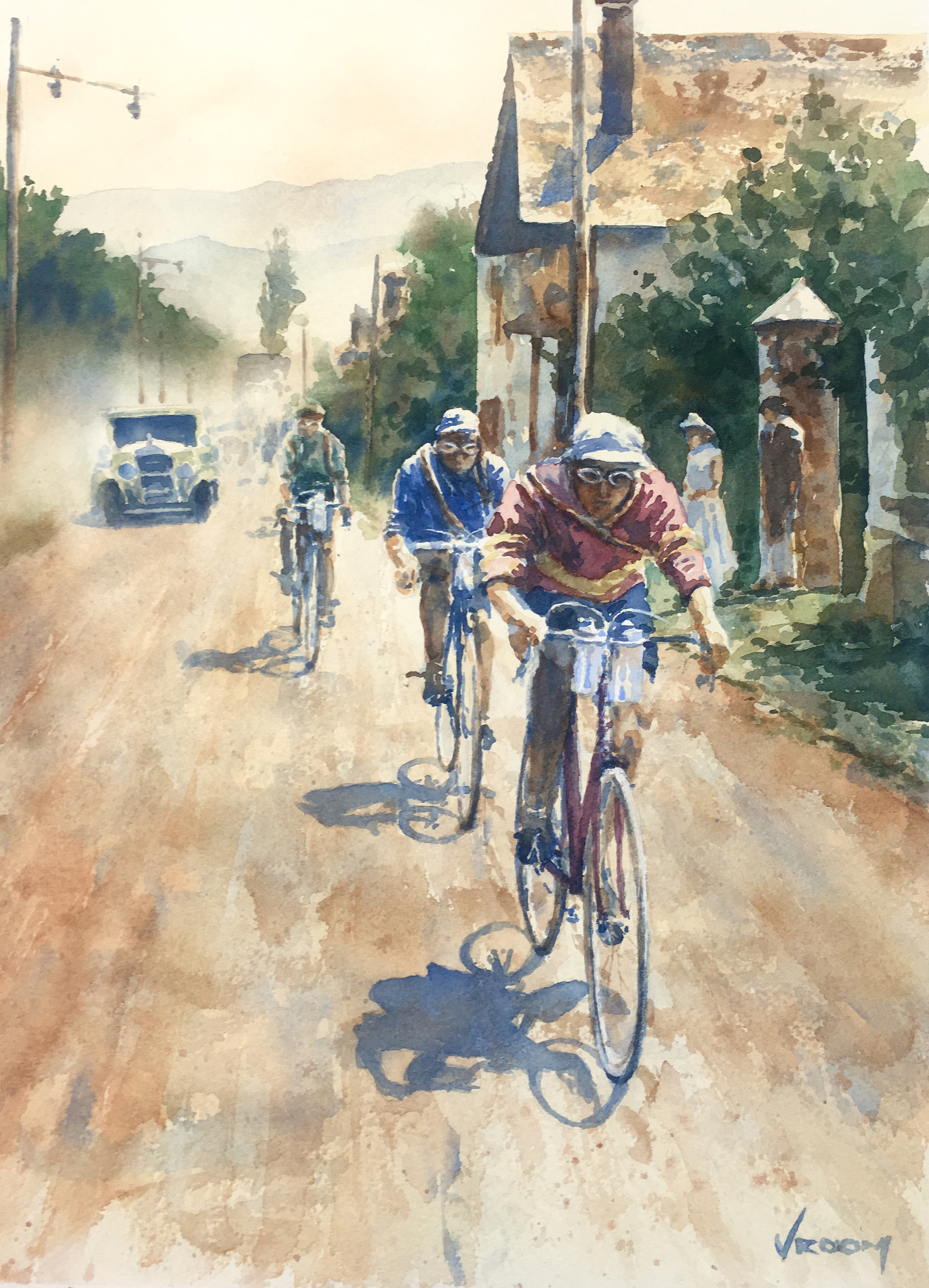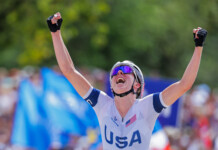By David Ward — I have often written of my excitement for the Tour de France. Each year, by the end of July, it has come and gone, my late night Tour watching is over, my constant efforts to shield myself from Tour news during the day is finished. Sadly, the daily spectacle of watching the world’s best bike riders battle over the roads of France has come to an end.

Watercolor by Richard Vroom. Follow Richard on Instagram: @richvroom
For the 100th staging of the Tour in July 2013, great effort went into making it a special event. And by my reckoning, the organizers succeeded well. While the fight for the overall victory was not as exciting as one might hope, there was plenty in this year’s Tour to render it as thrilling and unique a Tour as I can remember watching.
I had hoped the battle for the maillot jaune would be a more tightly contested affair. But Chris Froome pretty much wrapped it up on the first mountain stage, blowing all the competition away on Stage 8’s final climb to Ax 3 Domaines. While I was disconcerted with how he crushed the competition that day, I could not help but be impressed with his racing, and Richie Porte’s prodigious pacing. While hope remained that the gap might be closed down, with his dominance on that stage it was really more a question of whether Froome would falter.
He did not. Indeed, he weathered some tough challenges in the subsequent stages, and then really made the race his own on the stage finishing atop Mont Ventoux. I have ridden up that mountain and, in my opinion, it is the toughest of any climb included in the Tour, this year or any other. Froome’s attacks at the end when he first bridged to Nairo Quintana, and dropped Quintana in the last kilometer, were impressive. He was a very deserving winner, and it was the kind of bruising performance we have come to expect from a Tour champion.
I had expected the green jersey competition to be a close battle between Mark Cavendish and Peter Sagan. But like Froome, Sagan snared that early on. He and his Cannondale team planned and executed a strategy in Stage 7 that spit the other sprinters out the back, and set Sagan up to capture the intermediate sprint points and to win the stage. It was a brilliant demonstration of team strategy and execution, and thrilling to watch it develop and succeed. With the points from the win and the intermediate sprint, Sagan would have to blow big time to lose the jersey.
He did not. Rather, while he is not quite a power sprinter like Cavendish, André Greipel and Marcel Kittel, he was consistently second or third, continuing to scoop up important points to keep secure his lead in the green jersey competition.
Special mention has to be made of Kittel who was surprisingly dominant in this Tour with four sprint wins, Sagan was the best at scooping up sprint points, but the best pure sprinter in this year’s Tour was Kittel. And he made that clear with a thrilling sprint victory in the final stage on the Champs Élysées.
The only jersey that remained tightly contested throughout the Tour, and which came down to the penultimate stage, was the polka dot jersey for the best climber. With beaucoup points in the mountain competition awaiting the top finishers, the winner of the polka dot jersey would be determined here. Additionally, while Froome had the yellow jersey well in hand, 2nd through 5th places were separated by only 47 seconds at the start of this stage, with Alberto Contador holding an 21 second lead over Quintana, who had a 12 second lead over Roman Kreuziger, who had a 14 second lead over Joaquim Rodriguez. The final two spots for the podium would be determined on this stage.
So with the battle for the polka dot jersey and 2nd through 5th places overall both being battled out, this looked to be, and proved to be, the most exciting day of the Tour. On the final climb, atop which the stage would finish, Rodriguez, who had the most to gain, took the initiative and really pressed the pace. His efforts, along with those of Alejandro Valverde who at this point was working for Quintana, first whittled the lead group down to themselves, Contador, Kreuziger, Quintana, Froome and Froome’s ever present pal, Porte. Rodriguez’s continued efforts cracked Valverde, Porte and, significantly for Rodriguez, Contador and Kreuziger.
From there, it was a battle royale to the top between Rodriguez, Quintana and Froome. With less than two kilometers to go, Froome attacked, but could not put enough distance on his two adversaries who steadily came back to his wheel. Then Quintana attacked, and neither Froome nor Rodriguez could answer. Quintana soloed to the finish, with Rodriguez also passing Froome to finish second. Quintana scored the points to win the polka dot jersey in addition to the stage win. And he moved into 2nd place overall. Rodriguez gained enough time to move from 5th to 3rd. Contador was the day’s biggest loser, dropping from 2nd to 4th, and Kreuziger slipped to 5th.
From a nationalist standpoint, American Andrew Talansky, in his first Tour, was sitting in 11th overall at the start of this stage, 16 seconds behind Belgium’s Michal Kwiatkowski. He finished the stage in 6th place, just behind Richie Porte, gaining 1:36 on Kwiatkowski, more than enough to displace Kwiatkowski and take 10th place overall.
It was a great and exciting stage. The organizers had to be well pleased with how the Tour’s contest and excitement came down to this penultimate stage. The only way it could have been better was if the battle had been for 1st through 5th overall. But to watch a 23 year old Colombian in his first Tour climb onto the podium three times, once for the stage, once for the white jersey of the best placed young (25 or younger) rider, and once for the polka dot jersey, was thrilling.
And what about the double ascent up Alpe d’Huez in Stage 18? That was a stroke of genius. Frankly, it is probably no harder than any other stage where they throw in a couple of hors category climbs. But the legendary status of Alpe d’Huez shot the publicity value of this stage sky high. The descent, after the first ascent of Alpe d’Huez, down the Col de Sarenne, being a bit treacherous (as I can attest [see sidebar]), added to the excitement and anxiety of this stage.
For us Americans, Tejay van Garderen’s breakaway with Frenchman Christophe Riblon and Italian Moreno Moser, made this stage especially exciting. Van Garderen’s gear troubles, Riblon’s over shooting of the switchback turn, and Contador’s attack on the yellow jersey, made the descent of the Col de Sarenne rather exhilarating. And while it hurt to watch van Garderen lose this stage to a resurgent Riblon, I could not help but be excited for Riblon who was in tears over his win, and who became the first, and in the end only, Frenchman to win a stage this year.
Then there was the heartbreak of Jean-Christophe Péraud, the highest placed Frenchman in the Tour (9th overall) coming into the second time trial. He crashed while reconnoitering the course in the morning, fracturing his collarbone. Still, they managed to put him together enough to start the stage. He was actually having a very good ride, only to come into a turn within the last 2 kilometers of the stage, where his family was watching, and have his wheel slide out on a patch of paint. I cringed as he fell on that same shoulder, and could have cried as his wife came, in tears, to embrace him. The pain, physical and emotional, was intense and heartbreaking.
And what of Alejandro Valverde’s bad luck? He was placed second overall, only to have his wheel break during the windy Stage 5 into Marseille which split the peloton into echelons. With Contador in the first echelon and Froome caught out in the second echelon, the pace was high. While Valverde’s team tried to bring him back up, they couldn’t quite match the pace, and Valverde lost 10 minutes and any hope of a podium finish. To his credit, he battled back to pull himself into 8th place overall, and paced and mentored Quintana to his polka dot jersey and overall 2nd place finish.
Jens Voight, at 41 years of age, continued to provide excitement, getting into several breakaways, looking for a chance to slip away to a stage victory. In the end, none of them worked out, but what color and entertainment he provided.
There was also the spectacle of the Orica-Greenedge team bus getting stuck under Stage 1’s finish line gantry with the peloton fast approaching and the world’s greatest sprinters preparing to barrel down the finishing straight. First the finish line was moved back to the 3 kilometer mark, which would have been disastrous given the curve in the road at that point. Then, with only a few minutes to spare, the road was cleared and the finish was moved back to the original finish line. That was a first, and certainly had the organizers pulling their hair.
The breakaway wins of Rui Costa, Dan Martin and Jan Bakelants provided individual stage excitement. Who can help but pull for a breakaway to improbably succeed? And the surprise team time trial win of Orica-Greenedge which also garnered team member Simon Garrans the yellow jersey brought the team some welcome excitement and positive publicity following the spectacle of their bus stuck under Stage 1’s finish line gantry.
On the flip side, the poor showings of Cadel Evans and van Garderen were a real disappointment. While I did not expect Evans or van Garderen to win, I certainly hoped for high placings for them both. This also made van Garderen’s loss on Alpe d’Huez all the more painful.
This was indeed a unique and exciting Tour, making it’s 100th running as successful as Christian Prudhomme, the Tour director, could have hoped for. Now, it is back to the drawing board to try to design an equally successful Tour for next year. And for me, it is more sleep time. Also, per my wife, it is back to her to-do list for me. Here’s hoping that next year’s Tour comes quickly.








